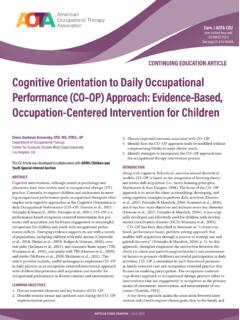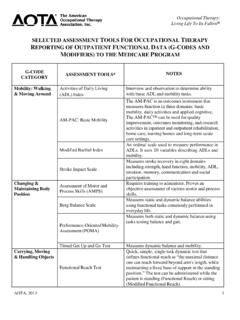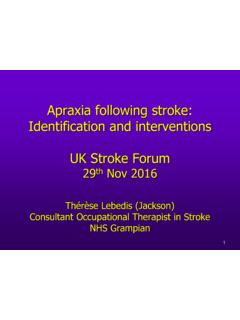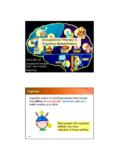Transcription of RCS One Model Calculation Worksheet for Skilled Nursing ...
1 RCS-I Model Calculation Worksheet for SNFs 1. The purpose of this Resident Classification System, Version (RCS-I) Calculation Worksheet is to provide a step-by-step walk-through to manually determine a resident's RCS-I classification based on the data from an MDS assessment. The Worksheet is a narrative representation of the grouper logic. We have carefully reviewed the Worksheet to ensure that it represents the logic currently discussed in the SNF PPS Advance Notice of Proposed Rulemaking (82 FR 20980) (ANPRM). In the RCS-I Model , there are four case-mix adjusted components: Physical and Occupational Therapy (PT/OT), Speech-Language Pathology (SLP), Non-Therapy Ancillary (NTA), and Nursing . Each resident would be classified into one and only one group for each of the four case-mix adjusted components. In other words, each resident is classified into a PT/OT group, an SLP group, an NTA. group, and a Nursing group. For each of the case-mix adjusted components, there are a number of groups to which a resident may be assigned, based on the relevant MDS data.
2 Specifically, there are 30 PT/OT groups, 18 SLP groups, 6 NTA groups, and 43 Nursing groups. As opposed to RUG- IV, in which a resident's classification into a single group determines the case-mix indexes and per- diem rates for all case-mix adjusted components, RCS-I classifies residents into a separate group for each of the case-mix adjusted components, which each have their own associated case-mix indexes and per diem rates. Additionally, RCS-I applies variable per diem payment adjustments to two components, PT/OT and NTA, to account for changes in resource use over a stay. The adjusted PT/OT and NTA per diem rates are then added together with the unadjusted SLP and Nursing component rates and the non-case-mix component, as is done under RUG-IV, to determine the full per diem rate for a given resident. The logic outlined below should be used in considering the RCS-I Model discussed in the ANPRM. This document is a draft Worksheet that is intended to aid stakeholders in their review of the FY 2018 SNF PPS Advance Notice of Proposed Rulemaking (ANPRM) and in the development of comments on the ANPRM.
3 This Worksheet does not represent a proposed payment Model , but rather follows the logic outlined in the ANPRM and accompanying Technical Report for consideration and comment by stakeholders. RCS-I Model Calculation Worksheet for SNFs 2. Calculation of cognitive Function Scale (CFS) Score RCS-I. The cognitive Function Scale (CFS) score is utilized in RCS-I resident classification for both the PT/OT and SLP payment components. The CFS score is calculated based on scores for two other cognitive measures, the Brief Interview for Mental Status (BIMS) and the cognitive Performance Scale (CPS). The CFS assigns one of four cognitive performance levels based on a resident's BIMS or CPS score. STEP #1. Determine the resident's BIMS Summary Score on the MDS based on the resident interview. Instructions for completing the BIMS are in Chapter 3, Section C. The BIMS involves the following items: C0200 Repetition of three words C0300 Temporal orientation C0400 Recall Item C0500 provides a BIMS Summary Score that ranges from 00 to 15.
4 If the resident interview is not successful, then the BIMS Summary Score will equal 99. If the resident's Summary Score is 99 (resident interview not successful) or the Summary Score is blank (resident interview not attempted and skipped) or the Summary Score has a dash value (not assessed), proceed to Step #2 to calculate the resident's cognitive Performance Scale (CPS). score. Otherwise, proceed to Step #3. STEP #2. If the resident's Summary Score is 99 or the Summary Score is blank or has a dash value, then calculate the resident's CPS score using the following steps: A) If resident is comatose (B0100 = 1), then the CPS score is 6. If this is not the case, proceed to Step B. B) If the resident is not comatose (B0100 = 0), then check if the resident has severely impaired cognitive skills (C1000 = 3). If this is the case, then the CPS score is 6 if in addition to impaired cognitive skills, the resident is completely dependent for eating or the eating ADL did not occur (G0110H1 = 4 or 8).
5 The CPS score is 5 if the resident is not completely dependent for eating (G0110H1 does not equal 4 or 8). Otherwise, if the resident is not comatose (B0100 = 0) and the resident does not have severely impaired cognitive skills (C1000 does not equal 3), go to Step C. This document is a draft Worksheet that is intended to aid stakeholders in their review of the FY 2018 SNF PPS Advance Notice of Proposed Rulemaking (ANPRM) and in the development of comments on the ANPRM. This Worksheet does not represent a proposed payment Model , but rather follows the logic outlined in the ANPRM and accompanying Technical Report for consideration and comment by stakeholders. RCS-I Model Calculation Worksheet for SNFs 3. C) If CPS does not equal 5 or 6 based on Steps A and B, determine the resident's Basic Impairment Count and Severe Impairment Count. For each of the conditions below that applies, add one to the Basic Impairment Count. a. In cognitive Skills for Daily Decision Making, resident has modified independence or is moderately impaired (C1000 = 1 or 2).
6 B. In Makes Self Understood, resident is usually understood, sometimes understood, or rarely/never understood (B0700 = 1, 2, or 3). c. Based on the Staff Assessment for Mental Status, resident has memory problem (C0700 = 1). Sum a, b, and c to get the Basic Impairment Count: For each of the conditions below that applies, add one to the Severe Impairment Count. a. In cognitive Skills for Daily Decision Making, resident is moderately impaired (C1000 = 2). b. In Makes Self Understood, resident is sometimes understood or rarely/never understood (B0700 = 2 or 3). Sum a and b to get the Severe Impairment Count: D) If CPS does not equal 5 or 6 based on Steps A and B and the Basic Impairment Count is 2. or 3 then follow the steps below. a. If Severe Impairment Count is 2, then CPS equals 4. b. If Severe Impairment Count is 1 then CPS equals 3. c. If Severe Impairment Count is 0 then CPS equals 2. E) If CPS does not equal 2 through 6 based on Steps A through D and the Basic Impairment Count equals 1 then CPS equals 1.
7 F) Otherwise, if CPS does not equal 1 through 6 based on Steps A through E and the Basic Impairment Count equals 0 then CPS equals 0. CPS Score: This document is a draft Worksheet that is intended to aid stakeholders in their review of the FY 2018 SNF PPS. Advance Notice of Proposed Rulemaking (ANPRM) and in the development of comments on the ANPRM. This Worksheet does not represent a proposed payment Model , but rather follows the logic outlined in the ANPRM and accompanying Technical Report for consideration and comment by stakeholders. RCS-I Model Calculation Worksheet for SNFs 4. Figure 1: Calculation of cognitive Performance Scale (CPS) Score This document is a draft Worksheet that is intended to aid stakeholders in their review of the FY 2018 SNF PPS Advance Notice of Proposed Rulemaking (ANPRM) and in the development of comments on the ANPRM. This Worksheet does not represent a proposed payment Model , but rather follows the logic outlined in the ANPRM and accompanying Technical Report for consideration and comment by stakeholders.
8 RCS-I Model Calculation Worksheet for SNFs 5. STEP #3. Calculate the resident's CFS score using the following mapping: Table 1: Calculation of CFS Score: BIMS. CFS Levels CPS Score CFS Score Score Cognitively Intact 13-15 - 1. Mildly Impaired 8-12 0-2 2. Moderately Impaired 0-7 3-4 3. Severely Impaired - 5-6 4. CFS Score: This document is a draft Worksheet that is intended to aid stakeholders in their review of the FY 2018 SNF PPS. Advance Notice of Proposed Rulemaking (ANPRM) and in the development of comments on the ANPRM. This Worksheet does not represent a proposed payment Model , but rather follows the logic outlined in the ANPRM and accompanying Technical Report for consideration and comment by stakeholders. RCS-I Model Calculation Worksheet for SNFs 6. Calculation of Total ADL Score RCS-I. The ADL score is a component of the Calculation for placement in RCS-I Nursing groups. The ADL score is based upon the four late loss ADLs (bed mobility, transfer, toilet use, and eating), and this score indicates the level of functional assistance or support required by the resident.
9 It is a very important component of the classification process. STEP # 1. To calculate the ADL score use the following chart for bed mobility (G0110A), transfer (G0110B), and toilet use (G0110I). Enter the ADL score for each item. Self- Performance Support Column 1 = Column 2 = ADL Score = SCORE. -, 0, 1, 7, or 8 and (any number) 0 G0110A =. 2 and (any number) 1 G0110B =. 3 and -, 0, 1, or 2 2 G0110I =. 4 and -, 0, 1, or 2 3. 3 or 4 and 3 4. STEP # 2. To calculate the ADL score for eating (G0110H), use the following chart. Enter ADL score. Self-Performance Support Column 1 (G0110H) = Column 2 = ADL Score = SCORE. -, 0, 1, 2, 7, or 8 and -, 0, 1, or 8 0 G0110H =. -, 0, 1, 2, 7, or 8 and 2 or 3 2. 3 or 4 and -, 0, or 1 2. 3 and 2 or 3 3. 4 and 2 or 3 4. STEP # 3. Add the four scores for the total ADL score. This is the RCS-I TOTAL ADL SCORE. The total ADL score ranges from 0 through 16. TOTAL RCS-I ADL SCORE. Other ADLs are also very important, but the research indicates that the late loss ADLs predict resource use most accurately.
10 The early loss ADLs do not significantly change the classification hierarchy or add to the prediction of resource use. This document is a draft Worksheet that is intended to aid stakeholders in their review of the FY 2018 SNF PPS Advance Notice of Proposed Rulemaking (ANPRM) and in the development of comments on the ANPRM. This Worksheet does not represent a proposed payment Model , but rather follows the logic outlined in the ANPRM and accompanying Technical Report for consideration and comment by stakeholders. RCS-I Model Calculation Worksheet for SNFs 7. Payment Component: PT/OT. RCS-I. STEP #1. Determine the resident's clinical category. To do so, first select the most appropriate category from the list below based on the resident's primary SNF diagnosis. Table 2: Primary Diagnosis Clinical Category Description Primary Diagnosis Clinical Category Description Received major joint replacement (hip, knee, shoulder or ankle) or spinal Major Joint Replacement or Spinal Surgery surgery during the prior inpatient stay which requires subsequent rehabilitative and Nursing services.














